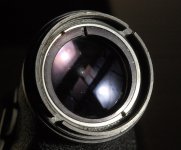FrankD
Well-known member
Bruce,
Steve posted something about this in another thread recently but I forget which at the moment. Basically you place the binoculars on a steady rest. Look through both barrels from a few inches away and decide which barrel looks to have a specific object centered in the field of view. Once you determine this then you can start tinkering with the other side. Make note of where the collimation ring slot is when you start and then just start moving it in small increments...clockwise or counter clockwise. Keep track of exactly how far you are moving it from the original starting point.
Eventually you will get it collimated.
Steve posted something about this in another thread recently but I forget which at the moment. Basically you place the binoculars on a steady rest. Look through both barrels from a few inches away and decide which barrel looks to have a specific object centered in the field of view. Once you determine this then you can start tinkering with the other side. Make note of where the collimation ring slot is when you start and then just start moving it in small increments...clockwise or counter clockwise. Keep track of exactly how far you are moving it from the original starting point.
Eventually you will get it collimated.




